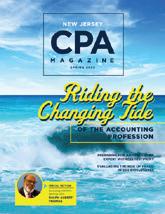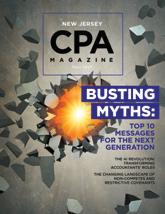SPRING 2024


SPRING 2024

KEY PRE-SALE STRATEGIES FOR OPTIMAL RETURNS
SERVICERS, MINDERS AND FINDERS: THE PATH TO BECOMING A LEADER
AI IN AUDITING: BIG-DATA OPPORTUNITIES AND CHALLENGES
Refer NJCPA membership to peers, colleagues and staff.
Offer them a $25 discount with code MGM24
We’ll send you a gift (or two or three) for each new member you refer.
Ask the candidate to include your name in their membership application.

Spread the rewards of membership.
njcpa.org/mgm


AIYSHA (AJ) JOHNSON, MA, IOM Chief Executive Officer & Executive Director ajohnson@njcpa.org
THERESA HINTON Chief Operating Officer thinton@njcpa.org
DON MEYER, CAE Chief Marketing Officer dmeyer@njcpa.org
RACHAEL BELL, CAE Managing Editor rbell@njcpa.org
KATHLEEN HOFFELDER, MA Senior Content Editor khoffelder@njcpa.org
DIANE ESPIRITU Senior Designer despiritu@njcpa.org
THE NEW JERSEY SOCIETY OF CERTIFIED PUBLIC ACCOUNTANTS
105 EISENHOWER PARKWAY SUITE 300, ROSELAND NJ 07068 973-226-4494 | NJCPA.ORG #NJCPAMAG
READ NEW JERSEY CPA
ONLINE AT NJCPA.ORG/ NEWJERSEYCPA
TO ADVERTISE OR PROVIDE SPONSORED CONTENT IN NEW JERSEY CPA Visit njcpa.org/advertising or contact Eileen Proven at eproven@njcpa.org or 862-702-5640
Before any sale can be realized, it’s important to prepare and strengthen the financial core of a business. Find out how to play a crucial role in helping businesses recognize new avenues for revenue growth, maximize their value and envision the endgame.
By embracing distinct roles, accountants can achieve long-term success. Those who have unwavering attention to detail and a relentless work ethic complement others in the profession who are the relationship builders and the acquirers of new clients.
Effective implementation of artificial intelligence depends on several factors, including the choice of methodology. There are several factors that should be evaluated to determine which methodology will meet the needs of a data analysis initiative.

The NJCPA is actively supporting and advocating for initiatives that recognize accounting as a science, technology, engineering and mathematics (STEM) subject and that allow STEM K-12 grant funding to be used for accounting awareness and education.
Bills making their way through Congress would greatly increase awareness of accounting to the K-12 communities and enhance underprivileged communities’ access to the accounting field. Last May, Representative Haley Stevens (D-MI) introduced H.R. 3541, which amends a federal supplemental funding program to promote career awareness in accounting as part of a well-rounded STEM educational experience. As of the middle of January 2024, it had more than 45 cosponsors. Senators Susan Collins (R-ME) and Jacky Rosen (D-NV) introduced a similar bill in the Senate (S.1705) that would also focus on educating K-12 students about accounting as part of the STEM initiative.
At the NJCPA, we have long believed the STEM designation would open up the accounting profession to a wider net of candidates who could consider becoming CPAs. The federal funding helps support awareness of accounting careers to students who may not have had any connection to the field in the past through relatives and/ or their communities.
To help move this initiative forward, the NJCPA has formed a Pipeline Advocacy Work Group comprised of New Jersey high school and university accounting educators. The group’s objectives consist of the following:
y Identify existing state programs that accounting students may be able to take advantage of under the STEM umbrella.
y Identify where and how New Jersey designates STEM subjects and then advocate to get accounting included.
y Help accounting departments in New Jersey higher education institutions to acquire status as a STEM program.
y Lobby the New Jersey congressional delegation to support federal legislation written by the AICPA that would designate accounting as STEM on a federal level.
The American Institute of CPAs (AICPA), NJCPA and 53 other CPA societies sent a letter to the Department of Homeland Security (DHS) last August requesting that accounting and five other
accounting-related subjects be considered STEM education by the DHS for degree programs in college and at the graduate level. This is an important stipulation since they would then have STEM Classification of Instructional Program (CIP) codes. Previous efforts were denied this designation in 2022, and new work is underway to show how technology is developed in accounting courses other than just being used in accounting.
Jan Taylor, CPA, CGMA, Ph.D., academic in residence and senior director of academic and student engagement at AICPA and the Chartered Institute of Management Accountants (CIMA), said on a recent webinar, “As STEM programs have changed, evolved or moved, the focus has gone more and more towards helping students to prepare for careers in areas where there is a lot of data and a lot of technology.”
She added that, at the AICPA, they are encouraging people to rethink accounting within all components of STEM. This, she said, means to think about sustainability and everything from basic technology and programming to artificial intelligence. With math implications, it’s important that “it’s moving from those basic mathematical skills to data analysis and risk assessment — things that our profession has a leg up on.”
While the DHS designation is being considered, the AICPA has developed a toolkit to reach out to colleges and universities to expand their accounting curricula to include additional technology-focused courses as well as to consider changing CIP codes to ones that are currently on the DHS list. The AICPA also has a template available for accounting professionals and educators to write to their local representatives in Congress. More information can be found at ThisWayToCPA.com/faculty.
You can follow the NJCPA's efforts at njcpa.org/pipeline. And we invite comments on our Open Forum at connect. njcpa.org

Selling a business involves meticulous planning and strategic actions long before the “For Sale” sign goes up. Accountants play a pivotal role in guiding clients on initiatives that can significantly boost the value of their company over several years.
The following strategies aim to maximize the business’s value years before the sale.
y Establish a vision for the endgame. Five years before considering a sale, it’s crucial to envision the future state of the business. Define the company’s goals and aspirations to shape subsequent decisions. Aligning short-term actions with long-term objectives becomes fundamental in augmenting a business’s marketability and worth. Start by deciding how much money the owner wants for the business, and work to make it a reality.
y Strengthen the financial foundation. Accountants play a pivotal role in enhancing a business’s financial health, directly influencing its overall value. Working with clients on meticulous record-keeping, maintaining transparent financial statements andimplementing tax strategies helps cut costs and boost profits, elevating the business’s worth in the eyes of potential buyers.
y Explore new avenues for revenue generation. Urge clients to seek to increase revenue by tapping into new markets, identifying niches through research and expanding into underserved areas. Diversifying lessens reliance on one customer base, which lowers risk, supports steady growth and increases value.
y Diversify products and services to mitigate risk and showcase adaptability. Encourage clients to
expand their product or service range, meet evolving consumer needs, and demonstrate adaptability and innovation. A varied revenue base mitigates risk, making the business less vulnerable to market fluctuations or economic downturns. This showcases adaptability and forward-thinking and positions the company for sustained success, appealing to potential buyers.
y Establish strategic partnerships and alliances. Propose seeking partnerships with other businesses to unlock synergies. Collaborations offer shared resources, expertise and access to new markets, which can reduce costs, diversify revenue and increase profitability and value.
y Promote leadership development and delegation. Encourage clients to identify and invest in future leaders within their organization. Grooming individuals to take on more responsibility, make informed decisions and confidently handle day-to-day operations helps decentralize decision-making and operational control. This lessens reliance on the owner’s direct involvement, strengthening the business’s autonomy, fostering growth and increasing value.
y Build a competent and self-sustaining team. Suggest resources to cultivate talent across various levels of the organization. By providing training, mentorship and opportunities for skill development, businesses can ensure that there’s a pool of individuals capable of stepping up when needed.

y Document processes for seamless transition. Help clients understand the significance of documenting their business processes. Create a procedural handbook that acts as a go-to resource for employees, providing clear instructions on how to carry out various tasks and procedures. A well-documented system facilitates a smoother transition.
y Enhance operational efficiency. Streamlining operations and optimizing efficiencies are vital for maximizing business value. Encourage clients to conduct operational audits to identify inefficiencies and implement best practices.
y Build a strong brand and customer base. Suggest prioritizing brand strength and customer loyalty to elevate the business’s perceived value. Advise clients to enhance brand equity by investing in targeted marketing, delivering exceptional customer service and leveraging technology for stronger customer relationships.
y Cultivate relationships and network. Recommend that clients actively network and cultivate industry relationships, as that can profoundly influence brand equity. Encourage clients to connect with potential buyers, industry peers and influencers to build trusted relationships and foster referrals, references and positive reviews.
y Invest in technology and innovation. In today’s rapidly evolving business landscape, technological prowess is a
critical determinant of value. Encourage clients to invest in cutting-edge technology, embrace digital transformation and stay ahead of industry trends. Innovative solutions drive efficiency and showcase the business’s readiness to adapt to evolving market demands.
y Mitigate risks and ensure compliance. Addressing potential liabilities and adhering strictly to legal and regulatory requirements is vital. Conduct risk assessments and implement robust compliance frameworks to minimize uncertainties for potential buyers, enhancing the business’s attractiveness and value.
y Establish scalability and growth potential. Buyers seek businesses with scalability and growth potential. Assist clients in demonstrating the potential for sustained growth post-sale by securing intellectual property rights, expanding into untapped markets or developing innovative revenue streams.
y Recommend tax planning strategies. Look for tax planning opportunities that will benefit the seller and buyer. Sellers aiming for higher capital gains want to structure deals to leverage exemptions and reduce tax burdens. On the other hand, buyers wish to have assets that allow for rapid expensing, enabling them to conserve cash through deductions and other tax advantages.
y Prepare to work with the new owners after the sale. Prepare clients
to engage with the new owners postsale, recognizing the value buyers place on seller involvement during transitions. Collaborate with lawyers to craft comprehensive agreements outlining roles, responsibilities, duration of collaboration and specific expectations. These agreements ensure a smooth transition and mutual understanding between parties.
y Create a transition plan. Support clients in crafting a comprehensive transition plan to retain customers and employees after the sale. Facilitate clear communication between stakeholders and potential buyers to align strategies focused on maintaining customer loyalty and a stable workforce during the transition phase.
y Promote clients’ expertise and guidance. Advise clients that their experience and insights are invaluable assets. Encourage clients to offer guidance on business intricacies, industry nuances and best practices to support new owners, regardless of their involvement in the business post-sale.
Increasing the value of a business five years before a potential sale involves a multifaceted approach encompassing financial fortitude, operational excellence, strategic foresight and market positioning. Accountants serving as trusted advisors can guide their clients through these strategic initiatives, ultimately maximizing the value of their businesses when it is time to sell. Carefully executing these steps sets the stage for a lucrative business transaction commanding the highest value for your client’s business.
Salvatore Schibell, CPA, CFP®, CGMA, MST, MBA, is the tax partner at Lawson, Rescinio, Schibell & Associates, P.C. He is a member of the NJCPA Federal Taxation and State Taxation interest groups and can be reached at salschibell@lrscpa.com.
READ MORE
SUCCESSION PLANNING KNOWLEDGE HUB njcpa.org/hub/succession

CPAs assume several distinct roles that contribute to their professional success as they progress from entry-level positions to becoming leaders serving clients or employers and becoming thought leaders and rainmakers.
By observing experienced leaders, adopting effective strategies and embracing these roles, accounting and tax professionals can learn to navigate their career paths with purpose and achieve long-term success.
The role of “servicers” is a vital one. These are the dedicated service partners and staff who navigate the intricacies of the accounting profession. They cultivate technical skills with unwavering attention to detail and a relentless work ethic. They form the backbone of the profession as they adeptly service clients and companies by providing accounting, auditing, tax and consulting services.
With a commitment to professional growth, these CPAs continuously learn and refine their technical expertise. The evolving new technologies, such as robotic process automation (RPA) and artificial intelligence (AI), promise to make their work more efficient and allow them to spend more time counseling clients and corporate leadership.
Establishing a solid foundation as a service professional can easily become the springboard for another career. However, top-notch servicers in public accounting set themselves apart through their mastery of client relationships. They foster client retention by delivering exceptional value to clients and colleagues alike.
Successful minders focus on leadership, relationship-building, collaboration, governance and effective communication. To become skilled minders, CPAs should observe and learn from accomplished leaders in the field. Studying their approaches and emulating their strategies fosters the development of leadership skills in relationshipbuilding, decision-making and coaching and mentoring.
Those who serve as minders also play a vital role in mentoring and developing junior staff. They provide guidance and support to help new accountants develop their skills and knowledge. Minders can also drive a positive and supportive work environment, increasing employee satisfaction and retention.
Here are some specific ways in which minders mentor and develop junior staff:
y Provide regular feedback and coaching.
y Assign challenging tasks that will help junior staff to grow and develop.
y Share their own experiences and insights.
y Be a role model.
y Create a positive and supportive work environment.
By mentoring and developing junior staff, minders help establish a succession pipeline and ensure that the accounting profession continues to thrive.
Finders (otherwise known as rainmakers) play a vital role in accounting as they possess expertise in business development, networking and relationship-building. They are responsible for acquiring new clients in public accounting and driving revenue growth for their organizations.
Aspiring rainmakers should hone their communication and interpersonal skills, cultivate a robust professional network and adopt a proactive mindset to identify and seize opportunities.

Transitioning from a grinder to a rainmaker requires developing a comprehensive understanding of client or business needs and the ability to offer sound solutions.
Successful rainmakers exhibit specific traits and behaviors that contribute to their success. They are proactive, strategic thinkers who actively seek opportunities, nurture relationships and position themselves as trusted advisors. Emulating their approach involves developing a strong personal brand, leveraging networking opportunities and continuously expanding industry knowledge. By adopting the strategies other successful rainmakers employ, CPAs can enhance their business development skills and accelerate their career growth.
Orcas and dolphins exemplify the power of teamwork and collaboration when capturing and hunting schools of fish. These highly intelligent marine mammals work together in packs to maximize their chances of success. The business world thrives on similar teamwork and collaborative efforts.
Drawing parallels between successful rainmakers and intelligent hunters in nature, we find that collaboration and teamwork play crucial roles in career progression. Top minders understand the value of working in groups, leveraging collective strengths and pursuing opportunities collectively. Fostering collaboration, sharing insights and building strong
professional networks allow individuals to harness the power of teamwork for success in accounting.
For example, forensic accountants attending, exhibiting and participating at legal conventions and conferences can benefit from working in collaborative teams to pursue prospects. These events bring together a diverse pool of lawyers, creating a fertile ground for networking and business opportunities.
Engaging in meaningful conversations, sharing insights and building relationships during professional conventions, conferences and similar gatherings can lead to fruitful partnerships, referrals and, ultimately, business success. Similar to the intricate choreography of marine mammals, navigating these events with a collaborative mindset enhances the likelihood of successfully seizing vast opportunities. Embracing a collaborative approach allows accounting professionals to tap into a broader range of prospects, increasing the likelihood of securing valuable outcomes.
Starting as a service professional provides a solid foundation for career growth. Embrace the roles of servicers, minders and finders. Learn from experienced, successful leaders, emulate their strategies and unlock the opportunities that lie ahead in your accounting career.
Henry Rinder, CPA, ABV, CFF, CFE, DABFA, CGMA, is a member of the firm at Smolin, Lupin & Co., LLC. He is a past president of the NJCPA and can be reached at hrinder@smolin.com
Get your CPA license. This is the most crucial step you can take to advance your career.
Get involved in professional organizations. The AICPA and state CPA societies provide a great way to network with other professionals and learn about new opportunities.
Attend professional events. This is another excellent way to establish new professional relationships and nurture existing ones.
Get involved in firm/company governance. This is a great way to gain experience and show your potential for advancement. Volunteer, raise your hand, get noticed.
Volunteer for local boards. This is an effective way to learn about corporate governance and network with local corporate and community leaders.
READ MORE
LEADERSHIP KNOWLEDGE HUB njcpa.org/hub/leadership
LEARN MORE
March 14 or April 24, Webinar
LEADERSHIFT: HOW TO EMBRACE DISRUPTION AND LEAD CHANGE
March 21 or April 24, Webinar
THE LEADERSHIP SKILLS OF TOMORROW: DELEGATE AND LISTEN
April 26 or May 3, Webinar
THE EMOTIONALLY INTELLIGENT LEADER njcpa.org/events

The world is generating an astonishing amount of data. As the total volume of data increases, so does its predictive capabilities. The discussion of artificial intelligence (AI) in accounting should, therefore, be focused on enhanced reporting, performance and risk management with this predictive data.
Machine learning algorithms can evolve the accounting profession from its role of doubleentry-based recordkeeping and compliance to a critical value for strategic business decision-making. This evolution demands accountants to have at least some level of technical understanding of big data and AI.
Perhaps unsurprisingly, the accounting profession has shown hesitancy towards adopting AI due to its “black box” nature, particularly in unsupervised learning algorithms. These algorithms, capable of complex decision-making, often lack transparency in their logic and reasoning. This lack of clarity can be at odds with the accounting profession’s focus on accuracy, traceability and verifiability.
Supervised learning methodologies rely on pre-labeled data to train predictive models, using metrics like accuracy, precision and recall to refine their predictions. In contrast to supervised learning where pre-labeled data exists and desired classifications are known, unsupervised learning algorithms analyze unlabeled data. They autonomously identify patterns and structures by finding similarities and differences among dataset attributes. It is useful in exploratory data analysis, anomaly detection and pattern discovery, where specific labels are absent or unknown, or where the goal is to uncover hidden trends.
Effective implementation of AI depends on several critical factors, including the choice of methodology. The selection and tuning of an appropriate AI methodology — be it a supervised or unsupervised method — is a critical step that shapes the model’s ability to return relevant and accurate insights. Method selection should include an evaluation of the objectives of the financial task, the nature and quality of the available data, the complexity of the problem at hand, and the desired outcome’s interpretability and transparency. Consider the following AI methodologies:
Classification algorithms are designed to categorize data into predefined classes. These algorithms, typically supervised in nature, learn from labeled datasets where each instance is tagged with a correct output label. By analyzing these datasets, the algorithm discerns patterns and rules that can be applied to new, unseen data to classify it accurately. The success of classification algorithms is often evaluated using metrics that assess how well the algorithm learned to classify the data, such as accuracy, precision, recall and the F1 score. One common example of a classification algorithm is Random Forest which functions by constructing numerous decision trees, each trained on different portions of the data. When it comes to making a prediction, each tree in this ‘forest’ casts a ‘vote’ for a particular class. The Random Forest then determines the final classification based on the most-voted class by these trees. This approach effectively combines the insights of multiple trees to reach a more accurate and reliable decision. Common hyperparameters in these algorithms include the number of decision trees in a Random Forest, the depth of each tree and the number of features considered for splitting at each node.

Clustering algorithms, an unsupervised methodology, are designed to group data points into clusters based on their similarity without relying on predefined labels. This method is useful for uncovering underlying structures in datasets where classification categories are not previously known. A common example of a clustering algorithm is K-Means, which segments data into distinct clusters by assigning each data point to the nearest cluster centroid and iteratively optimizes these centroids’ positions. The success of clustering algorithms can be measured by the sum of squared errors (SSE), which quantifies the compactness of the clusters by calculating the squared distance between each data point and its assigned cluster centroid and then summing these distances across all data points. The goal is to minimize the SSE, indicating that data points are closely grouped around their centroids. Key hyperparameters in clustering algorithms like K-Means include the number of clusters (K) and the initial placement of the centroids.
Association algorithms are used to uncover relationships or associations between variables in large datasets, typically through unsupervised methods. These algorithms are adept at discovering rules that highlight the likelihood of relationships between data items. This approach is especially powerful in scenarios where the interconnectivity or co-occurrence of items
needs to be understood, without any prior assumptions. A prominent example of an association algorithm is the Apriori algorithm, which is widely used for marketbasket analysis. This algorithm works by identifying frequent item sets or groups of items that often occur together in a dataset and then deriving association rules that predict the likelihood of an item’s presence based on the presence of other items. For instance, in transactional data, Apriori can identify that if customers buy item A, they are likely to buy item B as well. The effectiveness of association algorithms is often evaluated based on the support, confidence and lift of the derived rules, which each measure how frequently items appear together and the reliability of the rules generated.
Outlier Detection is a critical process in data analysis that involves identifying data points that significantly differ from the majority of data. These outliers can be indicative of errors, anomalies or fraud. Various techniques are used for outlier detection, including statistical tests, proximity-based methods and deviation-based approaches. The effectiveness of these methods is often evaluated based on their ability to accurately identify true outliers while minimizing false positives.
Outlier detection can intersect with other algorithm methodologies like classification, clustering and even neural networks. For instance, a classification algorithm might
be trained to distinguish between regular transactions and outliers, effectively categorizing data points as normal or anomalous. Similarly, clustering algorithms can group data, where points not fitting into any cluster may be considered outliers.
Integrating AI and predictive data in accounting will propel the profession towards a new era of business reporting. The benefits include enhanced risk management functions, strategic decision-making, and the ability to drive firm value, auditing and financial reporting. The future of accounting lies in embracing these advancements, not as replacements for human expertise, but as powerful tools that will fundamentally change the role of the accountant.
Melissa A. Dardani, CPA, CFE, MAcc, is the founder of MD Advisory Services. She is a member of the NJCPA Emerging Technologies Interest Group and several other interest groups. She can be reached at melissa.dardani@mdas.cpa.
READ MORE
AUTOMATION KNOWLEDGE HUB njcpa.org/hub/automation
ACCOUNTING & AUDITING
KNOWLEDGE HUB njcpa.org/hub/auditing

New quality management standards from the American Institute of CPAs (AICPA) affect every firm with an accounting and auditing practice. Design and implementation of a system of quality management (QM) is required to be completed by Dec. 15, 2025, with an evaluation required within a year.
In June 2022, the AICPA’s Auditing Standards Board issued the quality management standards, including Statements on Quality Management Standards (SQMS) No. 1 and No. 2, along with Statements on Auditing Standards No. 146. Additionally, Statement on Standards for Accounting and Review Services (SSARS) 26 was issued by the Accounting and Review Services Committee.
These new standards were prompted by the evolving business landscape. The power and use of technological resources have increased exponentially, both by businesses and firms. Additionally, the expectations of regulators, given high-profile business failures, are higher now than ever.
SQMS No. 1 introduces a new, riskbased quality management approach, moving away from a policies-based model. It underscores leadership responsibility,
requiring firms to tailor their systems to the unique circumstances of their accounting and auditing practices, allowing for scalability. The individuals assigned ultimate responsibility and accountability for the system of QM, on behalf of the firm, evaluate the system annually and conclude whether it provides the firm with reasonable assurance that the objectives of the system are being achieved.
The key components of this SQMS encompass the firm’s risk assessment process, governance and leadership, relevant ethical requirements, acceptance and continuance, engagement performance, resources, information and communication, and monitoring and remediation.
The firm’s risk assessment process is a new component that comprises the process the firm is required to follow in implementing the risk-based approach to quality management. The process entails the following three steps:
1. Establish quality objectives — additional quality objectives when necessary to achieve the objective of the system of quality management.
2. Identify and assess quality risks with a reasonable possibility of occurring and affecting the achievement of a quality objective.
3. Design and implement the firm’s responses and include certain responses specified in the standard.
The governance and leadership component addresses the importance of quality in the firm’s strategic decisions and actions, including financial and operational priorities, as well as firm leadership’s ability to influence decisions about the firm’s resources. Other matters such as the firm’s culture, how it demonstrates a commitment to quality and how responsibilities with respect to the system of QM are assigned may also be addressed. Relevant ethical requirements align quality objectives with ethical standards, ensuring compliance with relevant ethical requirements, including independence.
Acceptance and continuance involve judgments based on client information, engagement nature and the firm’s ability to meet professional standards. Engagement performance ensures understanding, supervision, professional judgment, consultations and proper documentation. The resources component emphasizes aligning human, technological and intellectual resources with professional standards.
The new information and communication component underscores the importance of an integrated information system supporting quality management. The monitoring and remediation process is an iterative, integrated system for continuous improvement, involving design and performance monitoring activities.
In summary, all these components operate in a highly integrated, non-linear manner. SQMS No. 1 signifies a proactive, tailored and scalable system that provides reasonable assurance of meeting objectives.
SQMS NO. 2
SQMS No. 2 addresses the appointment and eligibility of engagement quality reviewers (EQRs) and the performance of engagement quality reviews. Applicable to engagements requiring a review under SQMS No. 1, it emphasizes flexibility based on the level of significant judgments
in engagements. SQMS No. 1 allows firms to decide when an EQR is necessary, while SQMS No. 2 outlines processes for appointing eligible EQRs, focusing on competence, capabilities and authority when an EQR is determined to be an appropriate risk response.
SAS 146 AND SSARS 26
Statement on Auditing Standards (SAS) 146 emphasizes the auditor’s responsibilities for quality management, stressing professional skepticism, enhanced documentation and robust communication. The engagement partner (EP) assumes overall responsibility for managing and achieving quality, ensuring appropriate involvement, and considering audit nature, circumstances and firm policies before dating the report.
SSARS 26, the final standard in the suite, amends AR-C sections 60, 70, 80 and 90 to align with SQMS.
These new standards enhance firm leadership, accountability and governance through a risk-based approach. They address technology and external service providers, and they emphasize continuous information flow, proactive monitoring and effective communication. Additionally, they reinforce EQR requirements and enhance the EP’s responsibility for audit leadership and quality.
Jaclyn Veno, CPA, is a learning and development specialist at Galasso Learning Solutions. She can be reached at jaclyn@galassolearningsolutions.com
READ MORE
ACCOUNTING & AUDITING
KNOWLEDGE HUB njcpa.org/hub/accounting
LEARN MORE
March 18, Live Webcast
AUDIT QUALITY UPDATE AND THE FUTURE OF AUDIT njcpa.org/events
DO MORE
JOIN THE ACCOUNTING & AUDITING STANDARDS INTEREST GROUP njcpa.org/groups

Much has been written about the issues facing the accounting pipeline, and these issues are not going away anytime soon. This conversation has seemingly reached a crescendo during the last year, with enrollment figures, CPA Exam takers and accounting graduates overall declining and pushing this topic to the top of the profession’s collective mind. A critical part of the pipeline conversation is figuring out how to attract students to the CPA Exam in the first place.
I discussed this topic with some CPA colleagues who represent a cross-section of the profession:
“Plain and simple: Communicate how great the CPA designation is. The one thing I remember when taking my first accounting class is that my teacher told me, ‘CPAs can go anywhere and do anything.’ I thought this was too good to be true, but now, having the hindsight, I could not agree more! Being a CPA allows you to have access to jobs with higher authority and responsibilities (and higher pay), and, most importantly, there is a tremendous amount of job security. The CPA designation opens doors to nearly every industry and affords flexibility that most other professional designations don’t have the power to do.”
— Nicole DeRosa, CPA,tax partner, Wiss
“Accounting must evolve to reverse the decline in CPA Exam enrollment. There are a few ways to address this issue, and it starts with economics. Accounting pay has lagged behind other industries, so addressing salaries and compensation models is a great place to start. Reducing the credit hours needed for licensure eligibility can also remove educational barriers. Further, to attract more young talent to accounting, the industry needs to modernize, embrace new technology and methodologies, and learn lessons from other industries that have had similar transitions.”
—
ZacharyGordon, CPA, vice president of accounting, Propeller Industries

“To attract a wider range of students to the CPA Exam, it’s essential to emphasize the diverse career opportunities extending beyond traditional public accounting roles. Students should be informed about the potential to launch their careers in various sectors such as corporate finance, where they can engage in strategic financial planning, government accounting for public sector financial management, nonprofits focusing on fund accounting and grant management, forensic accounting for financial investigation, financial services with a focus on risk management and compliance, and innovative roles in startups. Highlighting this diversity in career paths can draw students with varied interests to the CPA profession, ensuring its continued growth and evolution in adapting to modern business needs.”
— BlakeOliver, CPA, founder and CEO, Earmark
“The CPA license provides countless opportunities throughout one’s career. As a CPA, you instantly gain the respect of business leaders. This is due, in part, to a long history of CPAs providing quality work and behaving ethically. The CPA designation is well known throughout not only the business community, but also the world. In many instances, simply by obtaining the CPA license, you will be provided opportunities that are otherwise out of reach. It is up to the individual to decide what happens with the opportunity, but just getting your foot in the door is typically the biggest obstacle. The CPA license gives you the qualifications to achieve whatever goals you may have in business.”
— Josh Allen McGowan, CPA, associate director in the School of Accountancy, Troy University
“We need to show the value proposition of having the CPA over just having an accounting degree. Students see the initial high costs to the Exam in time and money, but they don’t see the benefit right away. Having a CPA lets them become an entrepreneur at a young age. It’s a ticket to running their own business. And even if they don’t want to run their own business, the salary difference in industry for having the CPA over not having it is significant. It would be most helpful if firms would just pay new hires more upfront for having the CPA Exam passed. But until that happens, we must focus on the entrepreneurship aspect. — Jack Castonguay, CPA, Ph.D., assistant professor, Hofstra University and vice president, Surgent
Dr. Sean Stein Smith, CPA, DBA, CMA, CGMA, CFE, is a professor at the City University of New York – Lehman College. He is a member of the NJCPA Board of Trustees, participates on several interest groups and can be reached at sean. steinsmith@lehman.cuny.edu
READ MORE
CPA PIPELINE KNOWLEDGE HUB njcpa.org/pipeline
BECOME A CPA njcpa.org/becomeacpa
New Jersey businesses can access reliable, free information and resources that can strengthen operations, boost productivity and increase profitability. The New Jersey Business Action Center (NJBAC), a division of the New Jersey Department of State, supports business owners, entrepreneurs and stakeholders in the statewide business community by ensuring access to accurate and relevant education and guidance. The business advocates at NJBAC are always available to field any question or talk through ideas to find solutions that keep businesses, particularly small businesses, moving forward and achieving revenue goals.
To further its mission to help businesses in the Garden State succeed, NJBAC provides free and confidential technical assistance, advocacy and a variety of other support services through its offices, comprised of business advocacy, export promotion and small business advocacy.
y The Office of Business Advocacy (OBA) provides support and guidance for businesses of all sizes, at every stage of the development process. From site selection to expansion, from funding referrals to permitting assistance, OBA staff are committed to helping entrepreneurs and business owners quickly access efficient and relevant commercial real estate solutions across all industries.
y The Office of Export Promotion (OEP) provides essential guidance and resources for businesses looking to start or expand their goods and services export offerings. From exporting basics about regulatory compliance to custom procedures to reporting, OEP can help businesses lay the groundwork for global success. This office is a Small Business Administration (SBA) partner, collaborating at the state level for the New Jersey State Trade Expansion Program (NJSTEP). NJSTEP provides financial
awards through a competitive process for New Jersey businesses that are new to export, as well as those businesses that currently sell their goods and services to other countries.
y The Office of Small Business Advocacy (OSBA) provides real-time assistance for start-ups and small businesses seeking information about registration, annual reports, certifications, procurement and other business operations.
The division also oversees the Office of State Planning and the Cannabis Training Academy. By tapping into its deep understanding of the business landscape and its wide-reaching network, NJBAC connects businesses with who or what is needed to thrive and grow.
Businesses can take advantage of following free services from the NJBAC:
y Mentoring assistance: Whether already in business or just starting out, having a mentor provides a valuable resource. From creating a business plan to preparing financial statements or developing valuable social media strategies, having a business mentor can help a business succeed. The OSBA can help businesses connect with programs around the state that offer one-on-one mentoring opportunities.
y Financial resources: NJBAC advocates can refer businesses to a variety of financing options available through the New Jersey Economic Development Authority and communitybased micro-lending organizations. They can identify the specific programs for which a business may be eligible and help locate the resources that best meet their needs. They can also assist businesses with credit repair
services to help position a favorable application process.
y Licensing and professional certifications: NJBAC offers services that can help a business troubleshoot issues they may encounter with licensing or professional certifications.
y Navigating regulatory processes: Advocating on their behalf, NJBAC can coordinate with other state departments to quickly identify any challenges and formulate a sound and effective solution. They can also provide redevelopment guidance and coordination for municipalities and developers.
y Labor and workforce issues: Hiring and retaining the right people is crucial to the success of a business. NJBAC can guide companies through the variety of state training grants and resources to help recruit the best staff or train new and current employees. Advocates can help provide information on issues regarding employer responsibilities.
y Procurement assistance: When it comes to government contracts, New Jersey offers a variety of resources to help small companies take advantage of these important opportunities. From training and technical assistance, to email notification of requests for proposal (RFPs), NJBAC advocates can provide businesses with essential information and help them to be better positioned to compete for government contracts.
To connect with a business advocate, call the helpline at 1-800-JERSEY-7 or access the live chat at business.nj.gov.
Melanie Willoughby is the executive director at the NJBAC. She can be reached at melanie.willoughby@sos.nj.gov

When managing money, there are few guarantees, a lot of opinions and many truths. One impactful truth that can add tremendous value to investor portfolios is tax-loss harvesting, not just at the end of year, but as an all-year strategy. In bad years, money managers can help build up a war chest of losses to carry forward and use when markets rebound. Vanguard estimates that tax-loss harvesting can save investors 0.45% to 0.95% annually in after-tax returns, depending on volatility. However, as with most things, the devil is in the details.
Tax-loss harvesting involves selling and locking in portfolio losses to offset existing gains, future gains and a limited amount of ordinary income. Often, tax-loss harvesting is done only annually, with investors and money managers waiting until year end to sift through the losers and create some capital losses. Waiting, however, sets the stage for missed opportunities. Instead, use a more proactive approach and view tax-loss harvesting as a year-round activity. Stocks don’t wait until year end to offer the best opportunity to take losses.
In 2020, we witnessed the most recent example of a great tax-loss harvesting opportunity early in the year that dissipated towards year end when a sharp dip in markets in February and March was followed by a strong rally through 2020.
When applying the tax-loss harvesting strategy, a losing investment is sold and is often repurchased so as to not have lost-
opportunity costs in an investment. Once the losses are locked in, long- and short-term gains are offset in positions to neutralize or lower any tax impact. The “wash rule” prevents benefiting from a loss on positions repurchased 30 days after they are sold. There are, however, two workarounds. Under the current rule, investors can:
1) sell an exchange traded fund (ETF) and then buy an identical competing ETF and 2) sell a stock and buy a similar company or ETF that holds that stock. For example, an investor can sell Coke at a loss and buy Pepsi or an ETF that holds Coke, if there is an inclination that the consumer beverage industry is a great place to be.
Three are several basic premises to be aware of:
y Stocks ebb and flow throughout the year. To maximize the benefit of taxloss harvesting, investors and money managers need to actively look for low points and sell when they happen, not when loss harvesting is convenient. Obviously, every year brings a different experience for investors with differing low points, but the main objective here is looking for these dips throughout the year to maximize the tax losses.
y There are ways to enhance loss harvesting. Pooled vehicles, such as ETFs or mutual funds, benefit from a “sum of parts” approach, allowing tax-loss harvesting the losing parts of an index while holding onto the parts with gains.
y Mutual funds do have certain disadvantages. Because they tend to distribute capital gains near the end of year, without proper monitoring, these capital gains can blind side a well-intentioned tax strategy. The gains are based on the funds’ experience,
not the investors. So even if a mutual fund was purchased toward the end of year, investors are responsible for the total year’s realized gains, even if they occurred prior to purchase.
It is important to note that too much tax-loss harvesting can start to look like churning (excessive trading of assets to generate commission). However, in a fee-only, non-commissioned advisory relationship, transacting creates no additional fees, only tax-loss harvesting benefits.
It clearly takes more time to tax-loss harvest throughout the year and can lead to more activity in portfolios, which can be jarring for some. It also requires a disciplined approach and an understanding of how to swap between investment types to take a tax advantage but not at the sake of missing out on future potential opportunities. Is it worth it? Absolutely. The research around its benefits is clear in concluding that this strategy adds value. With an active tax-loss harvesting strategy, investors can help take some of the bite out of year-end distributions with a smaller check to the IRS.
Robert J. Mascia, CFBS, is the founder and CEO of Green Ridge Wealth Planning. He can be reached at rmascia@grwealthplan.com
READ MORE
FINANCIAL PLANNING KNOWLEDGE HUB njcpa.org/hub/ financialplanning
LEARN MORE
March 20 or April 4, Live Webcast
A HISTORY OF INVESTING AND A LOOK AHEAD njcpa.org/events
In today’s competitive business environment, success depends on consistently delivering exceptional service and nurturing employee happiness. Numerous studies have found that elevating employee happiness significantly impacts engagement, client service and brand loyalty. Gallup’s research found a direct relationship between employee engagement and business outcomes. According to Gallup’s “State of the American Workforce” report, companies excelling in client experience also demonstrate high levels of employee engagement. These companies report a 60% employee engagement score, leading to a notable 21% increase in profitability.
Regrettably, less than a quarter (23%) of employees feel genuinely engaged in their work. These individuals find meaning in their tasks, possess a strong team connection and take pride in their contributions, going above and beyond for both colleagues and clients. Engaged employees deliver exceptional client service because it is important to them.
Most workers (77%), however, are not engaged (“quiet quitters”) or are actively disengaged (“loud quitters”). Quiet quitters put in the minimum effort required and are psychologically disconnected from the firm. Loud quitters take actions that directly harm the firm. They actively undermine firm goals by challenging leadership and causing conflicts. Both classifications of quitters can harm client relationships, employee work interactions, stakeholder loyalty and brand equity.
Even so, Gallup found that nearly six in 10 quiet quitters can become engaged if things change. Quiet quitters said the firm’s culture was the top reason (41%) they were not engaged, not compensation or well-being. A few changes to how they are managed could turn quiet quitters into productive team members. They seek increased recognition for their work, better communication from firm leaders, clear goals, more robust guidance, expanded
opportunities to utilize their strengths and enhanced overall respect.
Implementing the following strategies will help cultivate a positive work environment and set the stage for a thriving and prosperous future for employees, clients and the firm.
y Cultivate a positive work environment. Creating a positive workplace culture is paramount. Begin by fostering an environment where employees feel valued, supported and appreciated. Encourage open communication, recognize achievements and prioritize work-life balance. Gallup’s report underscores the significance of feeling appreciated at work, with employees who receive regular recognition being seven times more likely to be engaged.
y Promote growth and development. Investing in employee growth and development is crucial for their happiness and loyalty. Providing avenues for upskilling, training and career advancement empowers employees. When they sense their growth is supported, they exhibit greater satisfaction and increase motivation to contribute positively to client interactions, aligning themselves more closely with the firm’s mission and values.
y Foster meaningful relationships. Encourage camaraderie and team bonding activities. The World Happiness Academy emphasizes the importance of social connections in cultivating happiness. Create platforms for collaboration, encourage teamwork and organize team-building exercises to strengthen employee relationships. Research conducted in 2022 by Indeed revealed
the social elements of work are far more important than compensation. Belonging is the top driver of well-being, while pay falls in the middle of the pack.
y Embrace flexibility and autonomy. Empower employees by offering flexibility in work schedules and autonomy in decision-making whenever feasible. The World Happiness Academy highlights that autonomy at work significantly contributes to overall happiness. Employees with control over their work tend to be more engaged, creative and committed to client success. While the debate continues over the advantages of remote or hybrid work, prioritize arrangements catering to employees and the firm. Everyone should consider how these choices affect workflow, deliverables and client relationships.
When employees feel genuinely content and engaged in their roles, their enthusiasm naturally extends to client interactions. The positive energy, dedication and passion they bring to their work invariably impact client relationships. Satisfied employees are more likely to deliver exceptional service, increasing client satisfaction and loyalty. A happy workforce isn’t just a morale booster; it’s a strategic imperative for firm growth and success.
Eileen Monesson, CPC, MBA, is the CEO of PRCounts, llc. She can be reached at emonesson @prcounts.com.

In the aftermath of the COVID-19 pandemic, professional services firms are facing challenges well recognized by CPAs and advisors to the industry. Issues such as dealing with a remote/hybrid workforce and talent acquisition have impacted overall business management as well as the accounting and tax reporting functions. Notably, the impact extends to state and local tax filings including the pass-through entity (PTE) tax regime that many states have recently adopted. It is to be expected that the managing partners and COOs of those firms will turn to their CPAs seeking advice on how best to navigate these challenges.
The shift towards remote/hybrid work models has presented both opportunities and challenges for professional services firms. While the flexibility offered by these arrangements can enhance employee satisfaction and productivity, many challenges exist. One major hurdle is maintaining effective communication and collaboration. In a remote/hybrid setting, the lack of face-to-face interactions can hinder spontaneous idea exchange and impede the development of a cohesive team environment. New hires don’t have a network and may not feel comfortable asking “dumb” questions. As such, a level of creativity is needed to find acceptable ways to maintain firm culture. Additionally, ensuring data security and compliance becomes a
paramount concern. Professional services firms deal with sensitive client information, and maintaining the same level of security outside traditional office boundaries requires a robust digital infrastructure and vigilant cybersecurity measures.
Another challenge facing firms with remote/hybrid work environments lies in managing performance and evaluating employee contributions to the firm. This becomes complicated in cases where there is no direct supervision. Thus, establishing transparent performance metrics and efficient monitoring mechanisms in a remote/ hybrid environment is crucial. Balancing the benefits of flexibility with the need for accountability poses a continuous challenge for professional services firms navigating the “new normal” of remote/hybrid work arrangements. It has become evident that firms must invest in technology, foster a culture of trust and adapt their management strategies to this evolving landscape to stay competitive and continue to grow.
Talent acquisition poses a formidable challenge for professional services firms in the competitive landscape of today’s world. The demand for specialized skills often exceeds the available talent pool, making recruitment an uphill task. To counter this, many firms are turning to mergers and acquisitions (M&A) as a strategic solution. M&A enables firms to not only onboard skilled professionals, but also to acquire established client bases. This strategy has the potential to accelerate a firm’s growth trajectory by instantly augmenting the workforce and expanding services capabilities.
However, M&A in the professional services industry is not without challenges. Cultural integration, aligning disparate processes and ensuring a seamless client experience post-deal are critical hurdles. Striking the right balance between organic talent development and inorganic growth through M&A is the key for professional services firms seeking to stay ahead in the talent acquisition game.
As with any M&A transaction, determining the best structure for the deal requires some level of due diligence to identify potential tax liabilities and compliance issues, particularly in the case of a merger of two firms or the acquisition of one by another. Additionally, assessing the tax implications of existing contractual obligations and contingencies, such as potential legal liabilities or pending litigation, is essential to avoid post-transaction surprises.
As firms change their business models and hire remote workers, they will find their geographic footprint expanding. Operating in multiple jurisdictions creates the potential for additional state income tax filing requirements, if nexus exists, as well as compliance with local employment laws. Further, as many professional services firms are taxed as PTEs, the benefits of the various PTE tax regimes should not be overlooked. Maximizing this deduction is dependent on accurate record-keeping practices as most states’ PTE tax calculations are based, in part, on state-sourced revenue. Firms operating in multiple jurisdictions must understand each state’s rules related to revenue sourcing (i.e., market based versus cost of performance).
CPAs are often the first ones clients call, so be sure to be prepared to help them navigate these challenges and opportunities. Sharing experiences in dealing with similar issues will add value and create stickiness to client relationships, leading to an improved client experience.
Karen Artasanchez, CPA, MST, is a shareholder at WilkinGuttenplan. She is a member of the NJCPA State Tax Task Force and Federal Taxation Interest Group. She can be reached at kartasanchez@wgcpas.com
“There’s a difference between hearing and listening,” said Sidney Deane (played by Wesley Snipes in White Men Can’t Jump, 1992).
Pop culture never captured it so well. Anyone who knows that movie knows the scene and that conversation! It touched on a universal theme — connection. If it doesn’t ring a bell, cue up some Jimmy Hendrix and kickstart your exploration into the realm of listening skills.
Pop culture aside, the importance of listening skills is nothing new in the business world. Psychotherapist Carl R. Rogers conducted research on this topic in 1952, notably featured in a classic Harvard Business Review paper titled, “Barriers and Gateways to Communication.” Yet, it appears we haven’t made strides in this vital skill since then; it remains an under-utilized skill. One reason could be that only 11% of business schools have listening skills as a learning goal. However, the residual impact of the pandemic is bringing a renewed focus on the lost art of this critical skill. Our shorter attention spans and mental wellness impacts may also contribute to the deterioration of some of our most important emotional intelligence skills, such as listening skills. The upside? Listening isn’t just an innate talent; it’s a skill. With the right knowledge and practice, anyone can hone it.
Here are three key concepts you can apply to improve your listening skills immediately:
y Awareness: No change ever happens without some type of awareness; upskilling is no different. When you engage with someone, ask yourself: What is my intention for this interaction? Am I here to get my point across? Am I just thinking of what to say next? Or am I just thinking about what’s for dinner tonight? In other words, are you more concerned about your own internal thoughts than you are about the other

person? Are you “in your head” or are you concerned about theirs? You can’t be truly engaged if you’re stuck in your own mental narrative.
y Conscious focus: Once you have an awareness, you can choose to be fully present or float by. If you want to be fully present, it requires you to redirect all of your energy to the other person. Once you practice conscious focus, you won’t be able to ignore it, and that may throw you off initially. But don’t worry, like any new skill, it takes time to sharpen. Once you recognize and catch that internal monologue, you now know what to do.
y Curiosity: Once you decide to turn your attention on the other person, try to understand their intentions, feelings and concerns. It’s here that you can practice the skill of empathy. This is where the connection starts! There is no doubt the other person will feel your attention. We’ve all been in conversations where we know the other person is NOT listening. You can really feel it. Authentic curiosity is palpable, just as the absence of it is glaringly obvious.
Here are a few ways you can demonstrate awareness, conscious focus and curiosity:
y Give all your attention. Put away the cell phone, laptop or other devices that will distract you from the other person.
y Be present. Eye contact, open posture, mirroring gestures, etc.
y Pay attention to non-verbal cues. Voice inflection, facial expressions and body language give a lot of information to others.
y Repeat what was said back to the person. This is a great way to show you are engaged.
y Ask clarifying questions to gain deeper understanding. An example is “What specifically did you mean by…?”
Enhanced listening skills offer a cornucopia of benefits. It can lower social anxiety, make employees more relaxed, increase awareness of strengths and weaknesses, enhance collaboration, increase your ability to influence and reduce turnover. Ultimately, listening is a gateway to connection, which we all crave! A final question: What would the impact of improved listening skills have on your life, productivity and work environment? Don’t just take my word for it — dive into your own research.
I’m curious what you will find and will be here ready to…LISTEN!
Thomas Metelski, CPA PCC, is CEO of Jump Coaching Connection, Inc. and host of The Value of Values podcast. He can be reached at thomas@ jumpcc.com
June 13, Atlantic City
Attend Thomas’s session at the NJCPA Convention & Expo — UNLOCKING LEADERSHIP EXCELLENCE: THE VITAL ROLE OF ENHANCED PEOPLE SKILLS njcpa.org/convention

So many of the leadership teams I work with struggle with holding people accountable. It’s so hard for some that they would rather avoid having the conversation and instead come up with a workaround. The problem is that those leaders then start to lose credibility with the rest of the organization. One reason these conversations are so difficult is because both people are emotionally primed entering into it. The deliverer of the message is worried about the direction it may go, and the receiver can usually tell bad news is coming and can feel their defensiveness start to rise.
Like many conversations, it’s how you say things more so than what you say. You should avoid going into a “parent/child” type of conversation where you try to shame the other person into the behavior you’re looking for by using phrases such as “I’m really disappointed you…” (judging); “Why did you do it that way when I told you…” (accusing); or “What made you think that was a good idea…” (judging and shaming).
These types of phrases will often generate a “child” response such as, “Sorry boss, I won’t do it again.” (chagrined with eyes and head down). Worse, the other person can shut down and not even hear your full message. They experience an emotional hijacking “freeze” response and are unable to hear anything further.
Getting these types of conversations started on the right foot often comes down to tone and staying out of judgement. Having delivered many workshops on hard conversations, I have come up with the following structure that involves four steps and a pause.
1) Make an appeal to “collaborate.” I’ll often say something like, “Help me with something…” or “I need your help with something…” or “Check my thinking on something because I want to make sure I’m not overreacting.”
2) State the where, when and what (behavior) you saw. For example, “Remember the meeting we had two weeks ago about you needing to bring Sara up to speed before the next requirements meeting? That meeting was yesterday, and she told me you haven’t reached out to her at all.”
3) Explain the impact of that behavior on you, the team and/or the organization. For example, “I thought when we chatted, I made it clear why we need to get Sara up to speed ASAP. This slows the whole project down, especially if you will be rolling off in a month.”
4) Ask if your telling of events is accurate. Ask, “Does that make sense?”
or “Is that fair?” or “Can you understand why I wanted to talk about this?”
At this point, you need to pause and see if he/she is willing to own their part of this mix-up. If you start the conversation tactfully, you’re hoping they step through the door and say, “Yeah, I can see why you wanted to talk.” Or, they may push back and get defensive, and you may need to start over at step one. This is about as far as you want to go in this conversation before you start the “where do we go from here” part. If they are not willing to own their behavior and how it contributed to this moment, they will not be ready for any “action planning.”
After step four, sit back and read their emotional state. Sometimes, you may have to end it there and say, “It looks like you still need to process this. Let’s pick it up tomorrow and we’ll figure out how to resolve this.” Or maybe they are ready to move right into the “where do we go from here” conversation. Rather than give them your action plan, ask them for their thoughts: “So, what do you think you need to do to get this right?” This approach makes it clear who needs to own this going forward.
I find when I use this structure it helps me have productive, tough conversations and people appreciate and respect me more.
Richard McLaughlin, M.A., is a principal at McLaughlin Consulting Services and can be reached at rich.mclaughlin@eosworldwide.com.
LEARN MORE
March 7 or April 8, Live Webcast
The American Institute of CPAs (AICPA) has revised the Statements on Standards for Tax Services (SSTS) that all CPAs who are members of the AICPA or licensed by the New Jersey State Board of Accountancy must follow. The revised standards are effective as of Jan. 1, 2024.
The revised format for the standards is as follows:
y SSTS No. 1, General Standards for Members Providing Tax Services: In addition to general standards on tax practices, this section also includes a new standard on data protection. Members are now required to make a “reasonable effort to safeguard taxpayer data.” There is also a section on the use of electronic tools. As innovations in artificial intelligence, as an example, create efficiencies in tax preparation and research, members must exercise due professional care when using these tools. This is an increasingly difficult area for many firms. There are similar challenges in the use of tax software and research services.
y SSTS No. 2, Standards for Members Providing Tax Compliance Services, Including Tax Return Positions: This is a new standard to specifically address tax compliance services and consolidates guidance from other standards. It gives specific guidance on requirements that need to be in place before a member can sign a tax return as well as additional tax return disclosure requirements.
An interesting standard (2.3.2.) in this section relates to the need to verify information received from the taxpayer or a third party when preparing or signing a return. The information does not have to be verified, but tax professionals should make “reasonable inquiries” if the information appears to be incorrect, incomplete or inconsistent to the tax preparer. There is a new requirement
that taxpayers must be notified of the ramifications of missing answers to questions on their returns. Members should not advise a taxpayer to file a return with a position that takes advantage of a weakness in the audit selection process of a taxing authority.
y SSTS No. 3, Standards for Members Providing Tax Consulting Services: Tax professionals do not have the obligation to update previously given advice based on new developments in tax law. However, this standard adds the requirement that developments must be disclosed if the tax preparer assists in implementing the strategies designed prior to the changes. New guidance is established regarding advice given related to disclosures of tax positions. The standard is met when the member advises the taxpayer on the appropriate disclosure. Tax professionals need to advise clients of potential penalties related to disclosures as well as ways to minimize them. The responsibility to determine if and how the disclosure is made is retained by the taxpayer.
y SSTS No. 4, Standards for Members Providing Tax Representation Services: This new standard informs tax professionals of rules related to their client representation before taxing authorities. Members should take steps to be technically competent in the area that is being examined. Specific rules related to the tax authorities should be studied as well. Various taxing authorities may have unique representation standards that vary based on the type of tax imposed. There is additional guidance related to issues that may affect the member’s ability to provide competent representation.
Tax practitioners are faced with client issues and an ever-evolving set of rules
and regulations. In addition, changes in technology can be helpful, but, if left unchecked, can lead to serious data protection exposures. Prudent attention to these updated standards can help to minimize these challenges.
P. Jeffrey Christakos, CPA/PFS, CFP®, is a wealth manager and principal at Westfield Wealth Management, LLC. He is a member of the NJCPA and can be reached at jeff@westfieldwealth.com
Andrew M. Christakos, CPA/PFS, CFP®, is a wealth manager and principal at Westfield Wealth Management, LLC. He is a member of the NJCPA and was selected to serve as a member of the AICPA’s Emerging Personal Financial Planning Task Force. Andrew can be reached at andrew@westfieldwealth.com
READ MORE
AICPA STATEMENTS ON STANDARDS FOR TAX SERVICES aicpa-cima.com/resources/ landing/statements-onstandards-for-tax-services
AICPA MAPPING OF EXISTING STANDARDS TO UPDATED STANDARDS EFFECTIVE JANUARY 1, 2024 aicpa-cima.com/resources/ download/revised-statementson-standards-for-tax-servicesno-1-4-1-1-2024
TAX KNOWLEDGE HUB njcpa.org/hub/tax
LEARN MORE
March 12 or April 12, Webinar
TAX PRACTICE STANDARDS njcpa.org/events
DO MORE
JOIN THE FEDERAL TAXATION INTEREST GROUP njcpa.org/groups




The NJCPA and its partners offer products and services to meet your essential needs.
DISCOVER RESOURCES TO ADVANCE YOUR SUCCESS AND SAVE MONEY.
y Business Products and Services
y Career Development
y Guidance and Learning
y Financial and Insurance
y Practice Management and Development
y Travel, Entertainment and Shopping
njcpa.org/marketplace
The 2024 NJCPA Convention & Expo, which will take place June 11 to 14 at the Borgata in Atlantic City, will bring together inspirational keynote speakers and representatives from industry, accounting firms, government and academia who will share their stories of leadership, business growth and innovation. The sessions will include practical applications of artificial intelligence (AI), how to maneuver the latest audit regulations, ways to unlock one’s leadership potential, how to foster better communication skills and finding CPA pipeline solutions.
Keynote speaker Matthew Luhn, a director, writer, story consultant and a 20-year Pixar story veteran, will show how storytelling can bridge the gap between business and emotion, effectively explaining how one’s story can become an unforgettable selling point. According to Luhn, “storytelling is the number-one business skill necessary to connect, motivate and lead people in today’s world.” He explains that stories compel us to engage in experiences, learn lessons and define our values and ourselves within our organization.
Kimberly Ellison-Taylor, CPA.CITP, CGMA, CIA, CISA, the founder and chief executive officer of KET Solutions LLC and former chair of the American Institute of CPAs (AICPA), will enlighten attendees on what it takes to overcome challenges in the accounting profession to grow, innovate and inspire. She expects to shine “a light on resilience, adaptability and the relentless pursuit of excellence” and to show how accounting professionals can make a difference in the lives of the public, businesses and communities.
John Higgins, CPA.CITP, founder and CEO of Higgins Advisory, LLC, will relate one’s story to the use of AI and explain how generative AI applications, such as ChatGPT, are well-suited to assist in every aspect of an accountant’s strategic planning. “This tool can help you generate suggestions to help establish your practice’s strategic vision, the specific initiatives needed to achieve the vision and generate

the narrative to communicate your strategic plan internally and externally. This can accelerate the planning process and improve the quality of the plan itself,” said Higgins. “The key word is ‘assist,’” he added, noting “generative AI applications augment your professional skills, knowledge and judgement; they do not replace them!”
Good listeners, however, can “differentiate themselves from AI in their ability to understand and connect with others,” according to Sandra Bodin-Lerner, MA, communication coach and principal at Be Compelling! LLC. “AI hears but does not listen,” she explains. In her presentation, she will focus on the cost of poor listening. “When you listen first to others’ stories, you are able to gather valuable data regarding their needs, beliefs and resources. This enables you to develop more-informed, relevant and effective responses — or stories. The good news is that listening is a skill and can be learned,” she adds.
This year’s Convention will feature a special panel focused the profession’s ability to attract and retain promising young
professionals. Led by NJCPA CEO and executive director Aiysha (AJ) Johnson, MA, IOM, the discussion will focus on what the NJCPA and its partners are doing to reverse a drying pipeline, advocacy efforts that are underway and what every CPA can do to help.
The four-day event will also include an economic discussion with Scott Clemons, CFA, a partner and chief investment strategist at Brown Brothers Harriman & Co., a New Jersey business and economic roundtable, and plenty of networking opportunities and entertainment from The Barnstorm.
Learn more about the Convention and register at njcpa.org/convention
The NJCPA Career Awareness Program had a successful campaign in 2023. More than 60 members visited 65 New Jersey high schools.
The message to students was clear: it’s an exciting time to be an accountant and to become a CPA. Presentations focused on what an accounting career entails, the benefits and what a student can do with their CPA license.
“Returning to my high school as part of the NJCPA’s Career Awareness Program was incredibly fulfilling. It was when I was at the desks those students now sit in that I decided to pursue a career in accounting. Going back to share my experiences as a professional was incredibly rewarding,” said Tara M. Baldwin, CPA, a manager at WilkinGuttenplan, who visited Hillsborough High School in Somerset County. “The accounting profession has evolved so much over the past few years, it is exciting to
share that with students — and hopefully play a small part in their decision to begin their journey to become a CPA.”
The teachers who were involved in the program were pleased with students’ interest after the presentations. Reacting to a discussion led by NJCPA member Michelle Gasiorowski, CPA, a partner at Bowman & Company LLP, Brandon Bond, jobs/co-op coordinator at Cinnaminson High School, said, “I believe it really helped to motivate a number of my students to consider accounting as a career. After your presentation, we had some great conversations. Students seemed very engaged in the topic and wanted to learn more.”
He added, “I thought the perspective of the different jobs you can do with an accounting degree really appealed to the students. A common theme from my follow up was that it is just not all about
spreadsheets and numbers, but one can really become a business consultant.”
Similarly, Keith P. Brady, MBA, M.S., M.Ed., business education teacher at Pequannock High School, was also satisfied with the student takeaways after Sushma P. Madanbhavi, CPA, a tax senior at Deloitte, presented. “Ms. Madanbhavi truly energized many of my students who were leaning towards the profession to take more proactive steps towards a fulfilling career path. They are excited to take the plunge and begin networking as well.”
NJCPA members who are interested in presenting at a high school next fall can indicate so at njcpa.org/volunteer. Those who wish to become a mentor to a high school student and be matched up with students throughout their college experience can apply at njcpa.org/mentor.

Whitman Transition Advisors has been helping CPA firms with their M&A needs since 2003. We are working with several new buyers in the marketplace that are paying cash up front, regardless of firm size. If your revenues exceed $1.50MM annually then we should talk today!
To confidentially discuss this opportunity, please email us at pw@ whitmantransition.com.
Seize a merger/acquisition opportunity with benefits for you. We are looking for firms ranging from $300,000 to $5,000,000 eager to combine forces as we continue to grow across northern NJ, Westchester and the Hudson Valley region. Goldstein Lieberman & Company is ideally situated to service all types of industries. Visit www.glcpas.com; email me, Phillip Goldstein, CPA, Managing Partner, philg@glcpas.com; or call me at 800-839-5767 to have a confidential conversation.
Monmouth County accounting practice grossing $700,000 annually is looking to sell to the right person. Practice is 50% business accounting and 50% tax. No Audits or Reviews. Firm has been in the area for over 20 years and enjoys a strong referral base. For a confidential initial discussion call my cell at 732-233-0550.



Matthews, Panariello P.C., a full service Bergen County firm located in Paramus, is looking to merge or acquire firms, sole practitioners, or accounts (audits, reviews, compilations and tax preparation and compliance services). We are a peer reviewed firm with a strong track record of client retention. We have been successful in prior acquisitions; let's talk. Visit our website at www.mpcpas.com
To confidentially discuss email Peter at pmanetta@mpcpas.com.
Quality Review for CPA firms: Audit, Review, Compilation, Employee Benefit Plans, Yellow Book, Revenue Recognition, Leases. Contact James M. Sausmer, CPA at 732-261-7710 or james.sausmer@gmail.com.
Single office space available in Paramus, NJ. Use of conference room. Great building, well maintained and easy for clients to get to. Share with another CPA, available to share in Tax and accounting Software. Call Jeff at 201-909-0335.
To see additional classified listings or to place an ad, visit njcpa.org/classifieds.


When NJCPA member Danielle Karacsony, CPA, sets her mind on something, she typically doesn’t let anything stand in her way. That explains how the Millennial from Jersey City passed all four parts of the CPA Exam on her first attempt with an average score of 93. It also explains how she worked for both NBCUniversal and The Walt Disney Company before the age of 30.
Danielle’s career path started out at KPMG as an audit associate, advancing to an audit senior. Though auditing offered great opportunities, she saw the chance to work for a company she admired since childhood — Disney. “I really liked auditing, particularly risk assessment. But you should always be aware of the job market. You always need to be prepared,” explains Danielle. After two years at KPMG, she jumped to Disney, where she spearheaded fixed-asset accounting and analyzed marketing expenses.
“I thought I wasn’t ever going to have the opportunity to work at Disney if I didn’t move to Florida or California, where most of their operations were located. I was on their website and saw a job posting in New York for their streaming business. I applied and was selected,” she explains. Disney licensed out their platform to other third parties, which meant she had to know all the income streams to do her job well. “Getting involved in the fixed-asset process was important for me to understand how the business worked as a whole,” she says. Danielle eventually made the leap to NBCUniversal’s Peacock streaming service at 30 Rockefeller Plaza in New York as the manager of accounting. Here, she manages its subscription revenue process; oversees the automation tools for revenue recognition; resolves discrepancies; and collaborates with operations, marketing, partnerships and technology advisors on
compliance with Sarbanes-Oxley (SOX) Act controls. In short, she focuses on improving its business processes.
Her department also implemented a new software solution that automatically recognizes revenue. “Our (streaming) procedures had to be scaled in such a way that we could handle moving from a small business to a large-scale business. The manual process we had for recognizing subscriber revenue was not capable of handling the volume of transactions,” she explains. Danielle also works with marketing and partnership teams over vouchers for companies like JetBlue.
As someone who enjoyed math throughout school, Danielle considered engineering before selecting accounting as her major. Danielle’s mother, Debra Karacsony, CPA, also a member of the NJCPA and formerly the director of quality control at Sax LLP, influenced Danielle’s choice to start in accounting. “She didn’t push me to become an accountant, but she said I should consider taking a class in college,” she says. Her mother’s only stipulation for Danielle and her sister, Amanda, now an interior architect, upon entering college was to select a major that led to professional opportunities. Danielle’s mother said, “Choose something you like, but you need to have a career path in mind.”
After initially entering the University of Delaware as an undecided major, Danielle took her first accounting class during her second semester and loved it. “Once I fully understood accounting, it was a no brainer. At the end of my freshman year, I declared an accounting major,” she says.
So, what specifically appealed to her?
“It is very logical; accounting involves a different way of thinking than I had ever thought of before,” she explains. Jobs were also readily available. The Big 4 and other accounting firms were frequently on campus, offering internships and jobs, she says. “They had many events which you could participate in and learn about the profession. It became the obvious choice.”
The NJCPA JobBank is a top source of New Jersey’s accounting jobs.
Ideal for hiring full-time, part-time or per diem staff Seeking new work? Upload your resume and sign up for job alerts.

njcpa.org/jobs
